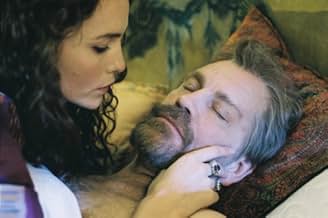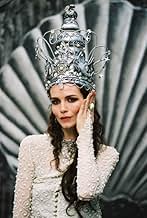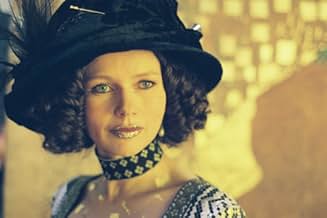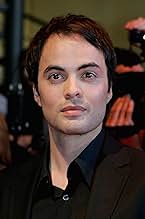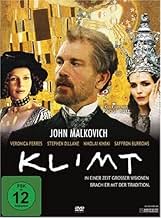Retrato del artista austríaco Gustav Klimt, cuyos retratos sexualizados simbolizan el estilo art nouveau de finales del siglo XIX.Retrato del artista austríaco Gustav Klimt, cuyos retratos sexualizados simbolizan el estilo art nouveau de finales del siglo XIX.Retrato del artista austríaco Gustav Klimt, cuyos retratos sexualizados simbolizan el estilo art nouveau de finales del siglo XIX.
- Dirección
- Guionistas
- Elenco
- Premios
- 1 premio ganado y 4 nominaciones en total
- Dirección
- Guionistas
- Todo el elenco y el equipo
- Producción, taquilla y más en IMDbPro
Opiniones destacadas
I didn't like this movie, and I have to say I admire Klimt paintings. I don't think that Klimt was so stiff and also sleepy. There is much more life in one simple photograph from the artist Wiki page, than in this whole movie. All these endless camera rotations around subjects! And too much too loud music... And actually an absence of scenario...
They tried to sell this movie to public - nudes, decadent atmosphere, this misleading label. The ratings show that they failed... I give it 5 for some visual enjoyment I had... and some women hats there were really-really amazing!
John Malkovich is talented but so quirky and full of himself he nearly ruins many of his movies. Surely he sees how affected he can sometimes be? Here he plays the Austrian artist Gustav Klimt in the years before WWI, and though we don't quite know what Klimt was like, we know he didn't play his life being John Malkovich. Biopics always struggle with the character against the actor, of course, since history is what it is, and so you swallow all this and see what the actor and the director can do within these constraints.
The director in this case is the late Raul Ruiz, the Chilean director who just died in Paris with a small cult following and a growing reputation. He concentrates not on Klimt's art, or even Klimt's attitudes as an artist of his time (this is the time of early Picasso, late Cezanne, and the growing influence of Gauguin). Instead it deals with Klimt's personality, which we know the least about, emphasizing his vulgarity, his obsession with nude women around him as much as possible, and his countless children for whom he apparently did as little as possible.
What might have been more interesting is to see a young Klimt being transformed by a 6th century Italian fresco with all its gold leafwork (this is true), or to maybe see him interact with the Vienna Secessionists in their effort, as a group, to break from the academy. What we get instead is a fantasy about the women around him, including a bizarre and willing entrapment of Klimt by a wealthy woman and her double (or twin?) which turns into a kind of erotic sex game with a man watching behind 2-way glass. Then there is a mysterious fellow who seems to only exist in Klimt's head--he's fascinating, yet only half realized.
If Ruiz had taken all this into something purely fantastic, where the trappings of history were shed, it might have been a transporting and special movie, an actual cinematic experience on its own terms. At times it tries, and there are some distortions and some beautiful moments, a bit out of place in the narrative, that stand on their own.
But mostly this lurches and jerks from situation to situation. The art is great, what we see of it, and the sets are nice, though even they are filmed too often with a yellowed dullness that defies the outrageous decorative beauty of the time. (I just happened to see "The Wings of the Dove" set in the same period and the set and costume design blows "Klimt" away). All of this is too bad especially for an art movie about an artist who believed in total aesthetic immersion--where everything, including your toilet paper holder, had to be an artistic component of a life of art.
It's not a disaster, but it's certainly a feminist's nightmare--where Klimt might have defended his painting of women as being honest and where the sex might have been free expression and liberation, the movie pushes all this into pure voyeurism and submissiveness. Women dangle and prance and decorate the movie sets, and your screen, the way Klimt, who was no feminist, might have approved, but which isn't accurate. It isn't about an equality in free loving sex, it's about women from a man's point of view. Period. Some of you will like that, but I did not.
The movie is decorated with dozens of naked women who mainly parade about, or who try to seduce Klimt. Given that he is not particularly handsome, charming or intelligent, I failed to see the attraction. Perhaps it was just his fame as a painter.
The interiors and costumes are opulent turn of the century Vienna. Elaborate Viennese pastries tempt the eye. The sets are the main appeal of the movie.
There is a lot of cat and mouse dialogue where the characters reveal nothing and say nothing while attempting to sound profound. It is all quite frustrating.
Nikolai Kinski plays the homosexual painter Egon Schiele in an exaggeratedly swish way, reminiscent of Da'an's hand gestures in Earth Final Conflict.
The costumes and hair treatments are so elaborate, that I could not for the life of me tell the female characters apart. Is this a new character or an old one in a new do? The characters all behave the same way and look similar. I didn't develop any bond with any of the characters because I could not even tell them apart.
¿Sabías que…?
- TriviaRyan Phillippe was considered for the role of Klimt.
- ErroresWhen Klimt mashes the cake in the man's face, the icing on the man's face is not covering his right eye. In the next close-up shot, there is a large blob of icing covering the man's right eye. In the next long shot when Klimt starts to wipe the man's face, the icing is no longer covering the man's right eye again.
- Citas
Klimt: Who art thou Asked the guardian of the night From crystal purity I come Was my reply And great my thirst, Persephone Yet heeding thy decree I take to flight and turn, and turn again Forever right I spurn the pallid cypress tree Seek no refreshment at its sylvan spring but hasten on toward the rustling river of Mnemosyne Wherein I drink to sweet satiety And there, dipping my palms between The knots and loopings of its mazy stream I see again, as in a drowning swimmers dream All the strange sights I ever saw And even stranger sights no man has ever seen
- Versiones alternativasA 131-minute-long Director's Cut was released theatrically in Austria and is available on DVD in the UK.
- ConexionesReferenced in Ricardo Aronovich, avec mes yeux de dinosaure du cinéma (2011)
Selecciones populares
- How long is Klimt?Con tecnología de Alexa
Detalles
- Fecha de lanzamiento
- Países de origen
- Sitios oficiales
- Idiomas
- También se conoce como
- A Viennese Fantasy à la manière de Schnitzler
- Locaciones de filmación
- Productoras
- Ver más créditos de la compañía en IMDbPro
Taquilla
- Total en EE. UU. y Canadá
- USD 97,656
- Fin de semana de estreno en EE. UU. y Canadá
- USD 2,332
- 24 jun 2007
- Total a nivel mundial
- USD 584,991
- Tiempo de ejecución2 horas 11 minutos
- Color
- Mezcla de sonido
- Relación de aspecto
- 1.85 : 1
Contribuir a esta página




